Lesson Plans: Timing is Everything

Timing is Everything
Lab Procedure
Summary
Today you are going to set up a simple pendulum and explore its motion for various numbers of swings and for different lengths of pendulum arms.
- Decides who will be the Data Keeper, the Materials Manager, and the Time Keeper. Record the roles on your data sheet.
- Materials Manager retrieves all materials listed from teacher. Reader should read all directions.
- Each group should place two chairs back-to-back separated by about 20 cm.
- Materials Manager turns the hook into the wood/cardboard and ties the 60 cm string to the hook. Next, s/he ties the 60 cm string around the mass to make a simple pendulum. Then, places the wood block on top of the chair backs with the pendulum dangling between the two chairs.
- A meter stick should be taped on the floor below the pendulum, so that when the pendulum is at rest, it dangles over the 50 cm mark on the meter stick. This point is called the equilibrium point.
- Checker and other group members should help confirm the set-up of the lab as seen below.
- Examine the Pendulum
Examine how the pendulum works. The Materials Manager should gently pull the pendulum out so that it is is above the 75 cm mark. When the Time Keeper looks directly over it, s/he sees the 75 cm mark covered by the mass.
Before the Materials Manager releases the pendulum, as a group, predict how far in the other direction it will go before returning. This distance of the pendulum from the start point to where it turns around will be called the its "width of swing". What will the reading on the meter stick be where the pendulum turns around? Write this prediction down on the group's data sheet.
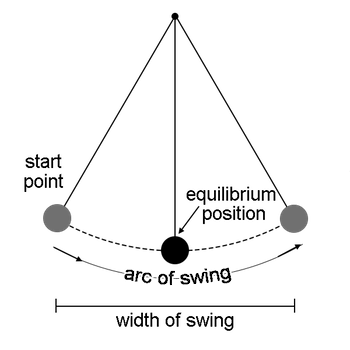
Definition of the equilibrium point and the swing of the pendulum.
Now, the Materials Manger should let the pendulum go, and the Time Keeper should observe the reading on the meter stick where the pendulum stops before returning - one swing of the pendulum. Record this number on the data sheet as the actual width of swing. How far did the pendulum move compared to how far you pulled it out from the equilibrium point? Is it what the group predicted?
Have the Materials Manager pull the pendulum back again to the 75 cm mark. Predict, as a group, where you think the pendulum will return to when it swings back toward its start point. What will the reading on the meter stick be? Record your prediction on the group's data sheet.
Once again, the Materials Manger should let the pendulum go, and the Time Keeper should observe the reading on the meter stick where the pendulum swings back toward the start position. How far back did the pendulum come? What is the reading on the meter stick? Is it what the group predicted?
- Trial 1: t1, t2, and t3
Let time = 0 when the pendulum is released from being held over 75 cm. When the Time Keeper says go, the pendulum is released and the watch started. When the pendulum reaches the point of maximum swing someone says "stop", and the watch is stopped. The Data Keeper records the time; the Materials Manager to take note of the width of the swing. Repeat the time measurement 5 times, making sure the Data Keeper records each trial on the Data Table under t1.
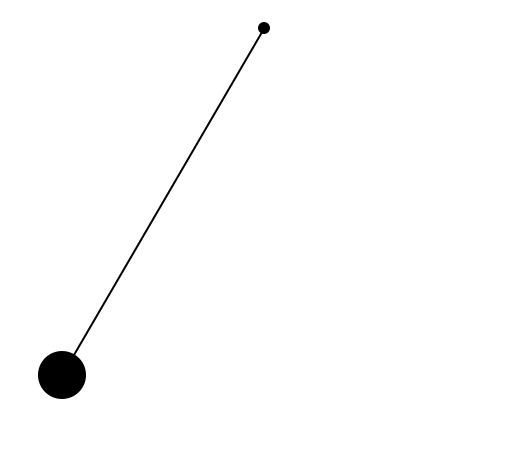
Animation of the t1 measurement. (Show me a still image of this measurement.)
Now repeat the procedure with someone saying "stop" the second time the pendulum reaches its maximum swing. The Data Keeper records each trial on the Data Table under t2.

Animation of the t2 measurement. (Show me a still image of this measurement.)
Repeat the procedure again, this time saying "stop" the third time the pendulum reaches its maximum movement. The Data Keeper records each trial on the Data Table under t3.
You can even do this for the fourth time if the pendulum continues to reach its maximum movement that many times.
The Data Keeper will record data for at least 3 complete swings of the pendulum (4 if possible). Each measurement should be made 5 times. Then the group should calculate the mean of those 5 repetitions and the Data Keeper should record that on the Data Table.
- Trial 1: ta, tb, and tc
Again, let time = 0 when the pendulum is released from being held over 75 cm. When Time Keeper says "go", the pendulum is released and the watch started. This time, the pendulum reaches its maximum movement when it swings back over 75 cm, and someone says "stop". The Data Keeper should record each trial as ta on the Data Table. Repeat this measurement 5 times.
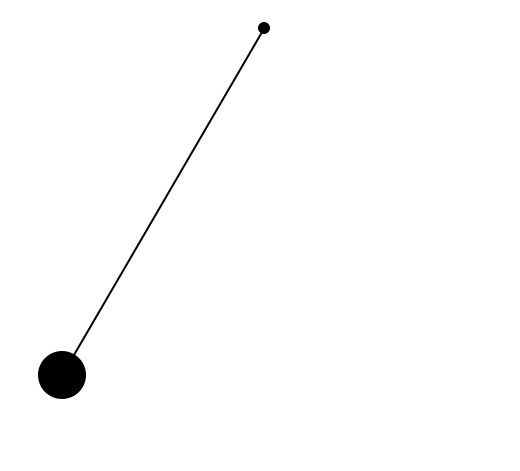
Animation of the ta measurement. (Show me a still image of this measurement.)
Now, repeat the procedure with someone now saying "stop" the second time the pendulum reaches its maximum movement near 75 cm. The Data Keeper should record this as tb) on the Data Table. Take this measurement 5 times.
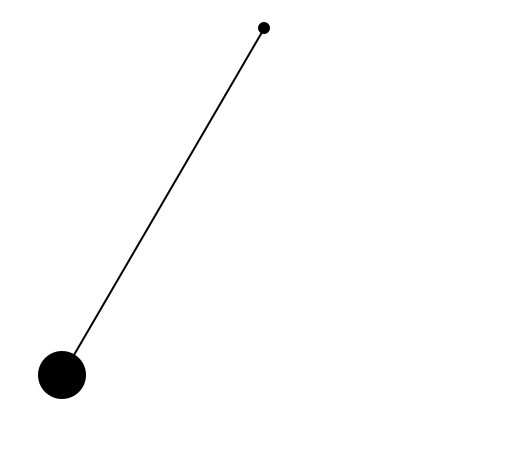
Animation of the tb measurement. (Show me a still image of this measurement.)
Repeat the procedure again, this time with someone saying "stop" the third time the pendulum reaches its maximum movement near 75 cm. The Data Keeper should record the time for each of 5 trials under tc on the Data Table.
You can do this for the fourth time if the pendulum continues to reach its maximum movement that many times.
The Data Keeper will record data for at least 3 complete swings of the pendulum (4 if possible). Each measurement should be made 5 times, and the mean determined from the 5 trials and recorded on the Data Table.
- After the data are collected and appropriately placed on the Data Table, it is now time to plot it. Each team member is responsible for making their own plot of the length of the swing versus the mean time in seconds.
- Trial 2
Repeat steps 4-12, but substitute the 30 cm string for the 60 cm string.
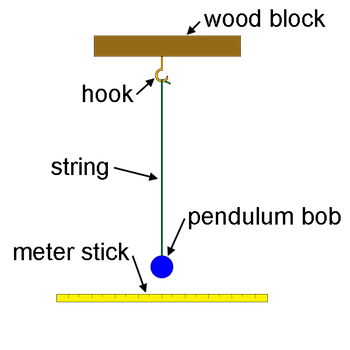
Pendulum setup
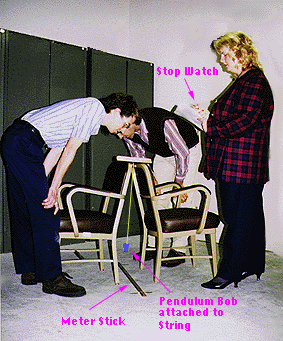
Lab setup

